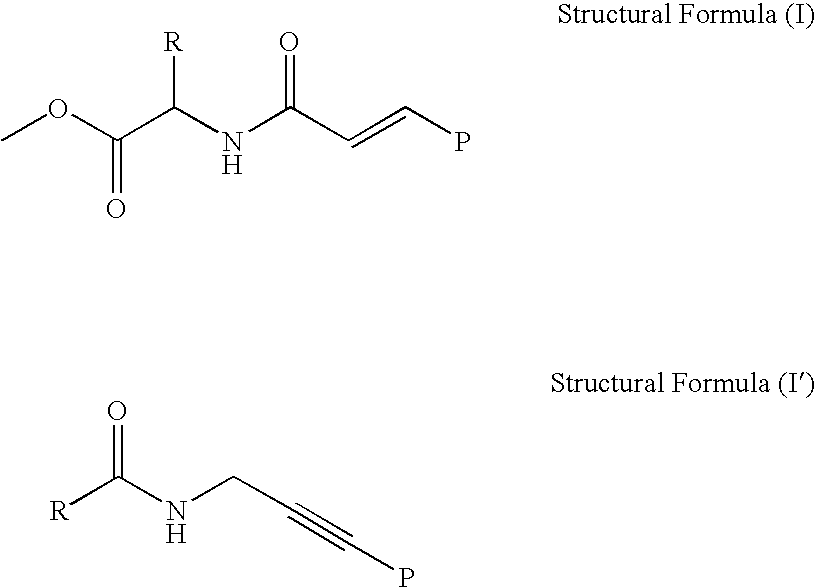Artificial enzyme and method for producing the same
a technology of artificial enzymes and enzymes, which is applied in the field of artificial enzyme production, can solve the problems of inability to achieve, inability to achieve, and very unstable ribozyme, etc., and achieves the effects of easy copying or amplifying, easy and selective recovery, and excellent stability
- Summary
- Abstract
- Description
- Claims
- Application Information
AI Technical Summary
Benefits of technology
Problems solved by technology
Method used
Image
Examples
example 1
[0184] In the way shown in FIGS. 4A to 4D, production (synthesis and identification) of the artificial enzyme according to the invention which has enzyme activity was performed. Specifically, first, by the process expressed by the following formula, 6 kinds of deoxycytidine relatives (C1-6) having a functional group at the 5th position of cytosine and 6 kinds of deoxyuridine relatives (U1-6) having a functional group at the 5th position of uracil were each synthesized (prepared).
[0185] Next, each of the synthesized (prepared) 12 kinds of the modified nucleoside dimer was one-to-one related to any one selected from 16 patterns of the relation table shown below, which is prepared by the one-to-one combination of 4 kinds of nucleosides constituting DNA.
TABLE 55′3′ACGTA—C2A—U3ACAC1C3CGC6U4CG—C4G—U5GTAU1C5TGU2U6T
[0186] Next, 12 kinds of the modified oligonucleotide amidite (M) represented in the above relation table were chemically synthesized by the phosphoramidite method. Specifica...
example 2
[0197] An artificial antibody A which specifically binds to the following compound A was synthesized in accordance with the artificial antibody synthetic method shown in the “functional molecule and process for producing the same” described in International Publication WO03 / 078623 by this applicant.
[0198] In the formula, “*” represents an asymmetric carbon.
[0199] An artificial enzyme catalyzing an amide condensation reaction was produced (synthesized and identified) as follows. First, in the same way as in Example 1, a random polymer pool (random artificial enzyme precursor pool) was prepared containing oligonucleotide sequence (N20-M10-Ub+Ub-M10 -N20 (DNA 82-mer)) composed of a fixed oligonucleotide sequence 20-mer (N20)−a modified oligonucleotide random sequence 10-mer (M10)−an uridine relative (Ub) represented by the following formula+the modified oligonucleotide random sequence 10-mer (M10)−the fixed oligonucleotide sequence 20-mer (N20). This is the “oligonucleotide sequence...
example 3
[0207] An artificial enzyme precursor (oligonucleotide sequence) was produced (synthesized and identified) in the same way as in Example 2, except that Ub of the artificial enzyme precursor (oligonucleotide sequence) obtained in Example 2 was changed to UcU represented by the following formula.
[0208] This oligonucleotide sequence did not exhibit catalytic activity for the amide bond hydrolysis reaction under the coexistence of 10 mM MgCl2.
[0209] Next, in the same way as in Example 1, a random oligonucleotide N20-M10-Uc+U-M10-N20 (DNA 82-mer) was prepared which is composed of a fixed oligonucleotide sequence 20-mer (N20)−a modified oligonucleotide random sequence 10-mer (M10)−an uridine relative Uc+uridine (U)−the modified oligonucleotide random sequence 10-mer (M10)—the fixed oligonucleotide sequence 20-mer (N20). Subsequently, with respect to the M dimer portion (M10) of the obtained random oligonucleotide, 2% mix block amidite was used as a raw material to thereby prepare a ran...
PUM
| Property | Measurement | Unit |
|---|---|---|
| Structure | aaaaa | aaaaa |
| Reactivity | aaaaa | aaaaa |
| Enzyme activity | aaaaa | aaaaa |
Abstract
Description
Claims
Application Information
 Login to View More
Login to View More - R&D
- Intellectual Property
- Life Sciences
- Materials
- Tech Scout
- Unparalleled Data Quality
- Higher Quality Content
- 60% Fewer Hallucinations
Browse by: Latest US Patents, China's latest patents, Technical Efficacy Thesaurus, Application Domain, Technology Topic, Popular Technical Reports.
© 2025 PatSnap. All rights reserved.Legal|Privacy policy|Modern Slavery Act Transparency Statement|Sitemap|About US| Contact US: help@patsnap.com



